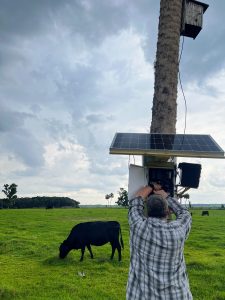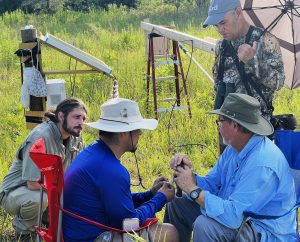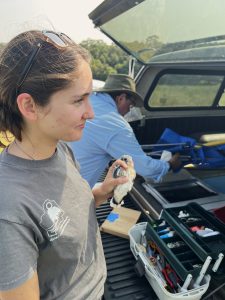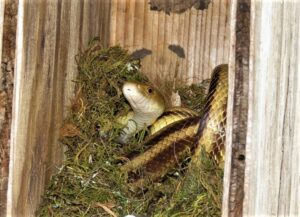Kestrel Nest Box Program
Watch Bob Simons’ program, Why Make Nest Boxes for Kestrels?, on YouTube here.
Kestrel Nest Box Program 2024-2025 Season Update
By Eric Amundson (as reported in the July August 2025 issue of The Crane newsletter)
The Southeastern American Kestrel (SEAMKE) is a subspecies of the American Kestrel. It is classified as “threatened” in Florida, the most protected category. Research data is sparse and AAS has considered it a priority to promote conservation strategies that can benefit this remarkable falcon’s success. AAS has special interest in where our fledged birds are traveling to determine new nest box support.
Alachua Audubon has been working with Dr. Ken Meyer of the Avian Research and Conservation Institute (ARCI). Eric Amundson leads other AAS volunteers in monitoring existing nest boxes that AAS has placed and maintained over the many years since Bob Simons began the program as a conservation effort. Dr. Meyer and his team use our successful boxes to place bands and transmitters on chicks prior to fledging. This typically is done approximately 25 days after hatching. The birds fledge by 30-32 days, weighing approximately the same as their parents. They spend up to a few weeks flying and hunting with the adults.
This past nesting season has seen the results of Dr Meyer’s tracking tagged birds from the last 3 years. Four new boxes were placed on articulating poles in areas identified by studying the routes frequented by tagged birds. Two of the boxes were located and occupied by kestrels within a few days of placement. The result was that eight new SEAMKEs fledged from Ashton Biological Preserve (ABP) and a nearby private property.
This was made possible by a partnership with Chase Pirtle, Director of the ABP, who facilitates our work both at Ashton and with private owners in the area. Chase has guided us around the 100-acre preserve and introduced his staff and interns to SEAMKE conservation efforts. They have provided real-time observation and hands-on support for AAS and ARCI in and beyond the preserve.
Dr. Meyer has enhanced data collection with 12 nest cameras that provide 24/7 observation. The solar powered systems are designed and fabricated by wildlife photographer Drew Fulton who works with Dr. Meyer on other sites in Florida. Drew has accompanied us on multiple sites where AAS maintains nest boxes.

Camera data collection and interpretation will add to the understanding of nestling diets, feeding rates, behaviors, and causes of nest failure. More data will be collected from the solar powered backpack transmitters placed on 20 fledglings that reached a weight of at least 100 grams.

Audubon Florida awarded Alachua Audubon the “Conservation Research Project of the Year” last year for our work with ARCI and the goals of identifying threats to the SEAMKE’s survival. (See the Jan-Feb 2025 issue of The Crane). Some of Dr. Meyer’s interests are natal dispersal distances from the hatch box to subsequent first breeding efforts and to further understand first year survival and causes of nest failure.

Alachua Audubon has contributed many volunteer hours and significant financial support to this effort which has been influential in securing generous grants from the Wagmore Foundation to ARCI in support of Dr Meyer’s ongoing research on the SEAMKE. Long-time volunteer Miguel Romero-Olvera began volunteering with Bob Simons in the 2021-22 season and guided me through the 2022-23 season. He was key in securing the Wagmore grant after demonstrating our work at Watermelon Pond to the Wagmore founders and others. He is now a master’s student in the UF/IFAS School of Natural Resources and Environment, Wildlife Ecology and Conservation Department.
Some results from the 2024-25 season:
The 2024-5 nesting season has concluded with 58 chicks fledged. The last chicks tagged on August 1 were from a double clutched nest at Watermelon Pond. A total of 24 birds were selected for tracking transmitters. 51 chicks were banded with a color tag on left leg and metal band on the right leg prior to fledging.
29 boxes monitored.
15 boxes used for nesting.
58 chicks fledged.
24 chicks fitted with transmitters.
51 chicks banded with a metal band on
one leg and a colored band on the other.
We look forward to any sightings that can be reported to AAS. Plans are now being made for the 2025-26 season with nest box construction and opportunities for new locations informed by the data that ARCI will be providing from the tagged birds and sightings provided by the wider birding community.
Kestrel Nest Box Program 2022-2023 Season Update
Prior to the 2023 breeding season we provided maintenance to each nest box between October 2022 and January 2023. AAS monitoring of 39 nest boxes between March and June 2023 concluded with 15 successful nests, resulting in at least 25 verified fledges (but possibly as high as 45) compared to 19 fledges in 2019, 16 in 2021, and 15 in 2022 respectively. Maintenance, monitoring, and data collection of the kestrel nest box program is led by Eric Amundson and Miguel Olvera with assistance from Audubon volunteers and interns. Volunteers included Austin Gregg, Karen Brown, Gary Gossman, and Jose-Miguel Ponciano. The 7 nest boxes located on Alachua County Property (Metzger Tract at Watermelon Pond) were also assisted by County employees Milo Neelands and Cory Gillis.
In addition to the regular maintenance and monitoring of kestrel nest box use in this program, in 2023 AAS partnered with Dr. Ken Meyer of the Avian Research and Conservation Institute (ARCI) to tag and track fledgling Southeastern American Kestrels. This effort was initiated to follow tagged birds to potential locations for new nest box placement opportunities. We hope to enlist local landowners in assisting with this effort. Dr. Meyer, with technology he supplied, tagged and banded 3 male and 2 female nestlings from nest boxes on County property. Alachua Audubon volunteers and interns were able to assist and observe this process. Nestlings were removed by hand, banded and secured with a transmitter with a teflon harness, and quickly returned to the nest. All banded birds successfully fledged. Eric, Miguel, and AAS interns began tracking banded male kestrels on a weekly basis. Some have returned and will be observed again during the 2024 season. This data has yet to be analyzed. This project continues on a largely volunteer basis with funding provided by AAS, technology and expertise by Dr. Meyer and ARCI. Dr. Meyer with AAS support has just received news of a $25,000 grant from the Wagmore Foundation to be used for this project in 2024. We expect these results will add to scientists’ understanding and research of the Southeastern American Kestrel.
Our thanks are also extended to Robert “Hutch” Hutchinson for his efforts on our behalf.
In 2006, long-time board member Bob Simons launched our Southeastern American Kestrel nest box program, building, installing and maintaining nest boxes to support these small falcons that require cavities for nesting. This resulted in about 130 boxes being put up in North Florida between 2006 and 2015. Many of the boxes have been used by kestrels or screech owls for nesting but, to begin with, very little monitoring was done. In 2019, it was decided to revive the program, making use of the abilities and energy of interns from the new Alachua Audubon college internship program initiated by UF Professor Katie Sieving. A committee, led by Bob, was formed to carry out the mission.
Southeastern American Kestrels are a non-migratory subspecies of kestrel found in open pine savannahs, sandhills, prairies, and pastures in Florida and the southeastern United States. They are listed as threatened in Florida due to a decline in nesting and foraging habitat.

A telescoping pole camera for monitoring nest boxes was purchased with a grant from Florida Power & Light. With the help of enthusiastic college interns, we built new kestrel boxes and bluebird boxes. We also started doing maintenance on some of the old, installed boxes, using an extension ladder to access them (most are 12 to 18 feet off the ground). Boxes have been installed on utility poles, pine trees, cabbage palms, and other structures in cattle pastures, agricultural fields, private lands, and other habitats supporting grasshoppers and small lizards, the primary food of kestrels. Hazards to nest boxes include lightning strikes to the host tree, other tree mortality, utility pole replacement, and nest box deterioration from weather exposure. Wasps are a frequent hazard, building nests inside or on the underside of boxes.

Each year in November we begin making trips to check on installed boxes to inspect, repair and clean them and to add nesting material when needed. Interestingly, kestrels do not gather their own nesting material. During the 2019-2020 season, the team began adding aluminum sheet metal bands to the trees and poles that support normally active nest boxes to discourage predators such as raccoons and rat snakes from raiding the nests. We also apply Amdro fire ant bait around ant nests active bird nesting locations. Fire ants are the primary predators of kestrel nestlings. In addition to kestrels, boxes are sometimes occupied by Eastern Screech Owls, flying squirrels, fox squirrels, Eastern bluebirds, Great-crested Flycatchers and other inhabitants.

In 2022, we saw increased nesting both at and around Ichetucknee Springs State Park (5 nesting pairs). These boxes are monitored by park staff. We also saw increased nesting on the county-owned property at Watermelon Pond (7 nesting pairs). There are other active nests in boxes scattered around the western half of Alachua County.
Some boxes put up in Columbia, Gilchrist and Suwannee Counties have been maintained and monitored regularly by Richard Melvin, a licensed bird bander. Six boxes put up on the Florida Fish and Wildlife Conservation Commission (FWC) property at Watermelon Pond are monitored by FWC staff. Others have put up boxes in Marion and Clay County.
Nest boxes are scattered widely throughout Alachua County and beyond. There is rarely enough time and assistance to check all known boxes so attention is focused on those with documented kestrel nesting activity. Nesting begins in mid-March and is completed by early June. During this most exciting period, the telescoping camera is used to monitor the boxes and photograph eggs and chicks.



To date, Bob Simons and friends, colleagues, his wife, Erika, and interns have built about 150 kestrel boxes and about 220 bluebird boxes. From the limited amount of monitoring (further hampered by Covid), we know that from 2019 – 2022, at least 54 kestrel chicks and 12 screech owl chicks have been seen in the nest or fledged. Almost 200 eggs of kestrels, screen owls and bluebirds have been seen but we were unable to follow up to see if they hatched and fledged.
Going forward, we still have many old boxes to check, and have found potential locations for putting up new boxes. We have continued to make use of interns, rejuvenating old boxes, putting up new boxes, and monitoring the boxes with the pole camera as kestrels and screech owls begin their nesting season. We hope to be able to increase the number of people checking boxes so that we can gather more data, especially during May and June when chicks can be counted. Many of the interns so far have reported that this work has been one of their most rewarding and most hands-on experience as college students. This makes the project a success all around.
 This screech owl chick was spotted in one of our boxes in Suwannee County.
This screech owl chick was spotted in one of our boxes in Suwannee County.